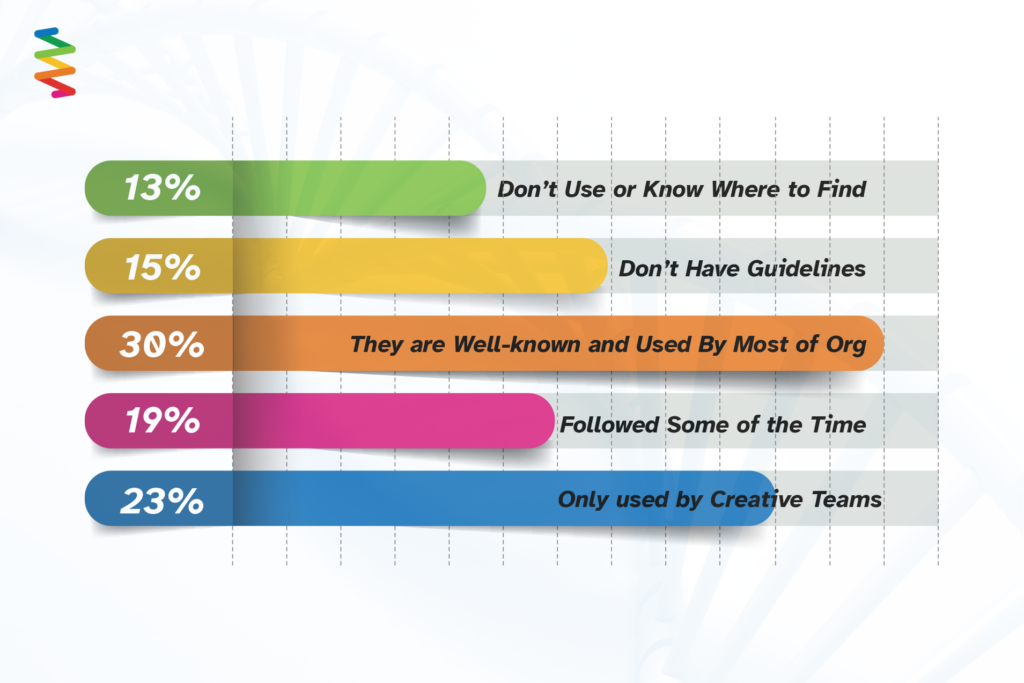Crafting Your Company’s Visual Brand Identity
Tips, Tricks, & Best Practices
Key Points
- Visual brand identity, including color palettes, typography, and design elements, helps a brand stand out and communicate its core values.
- Evaluating and improving the brand’s current image involves aligning visuals with company values, ensuring assets support the brand mission, and using feedback for refinement.
- Refining visual identity for a target audience involves understanding customer preferences, tailoring visuals accordingly, and maintaining consistency across all marketing.
- Consistency across all brand touchpoints is ensured through brand guidelines, uniform style in marketing materials, and collaborations with design teams.
Table of Contents
Recap: What is Your Brand’s Visual Identity and Why is it Important?
Visual identity is the aesthetic presentation of a brand that creates a lasting impression on potential customers. In today’s visually-driven world, a strong visual brand identity is essential for any brand to stand out and make an impact. Research shows that people process visual information faster and remember it longer than text alone, highlighting the importance of visual branding.
What’s more, design-driven companies with strong visual brand identities have outperformed the S&P Index by 228% over the past ten years.
The key components of a consistent visual style include color palettes, typography styles, and design elements that work together to communicate the brand’s core values and target audience. Consistent presentation across all marketing materials, digital presence, and physical assets enhances brand recognition and fosters an emotional connection with current and potential customers.
Evaluating Your Brand’s Current Image
When it comes to building a strong brand, one important aspect is evaluating and improving your brand’s current image. This involves assessing your visual brand identity, messaging, and overall customer perception of your brand.
By taking the time to evaluate and make necessary changes, you can ensure that your brand accurately reflects your values, appeals to your target audience, and stands out in a competitive market.
Let’s explore some key questions you should ask yourself when determining whether your brand’s current image is sufficient for the market.
Is it Aligned With Your Company’s Values and Messaging?
Your visual brand identity is a powerful tool for building a strong and consistent brand attitude and for evoking certain emotions and opinions in your target audience. Ensuring that your visual components are aligned with your company’s values and messaging is crucial for making a lasting impact on potential customers.
Do Your Visual Assets Support Your Brand’s Mission and Purpose?
To evaluate your current visual assets, start by analyzing whether they successfully communicate your brand’s mission and purpose. Look to the mental wellness platform Real as an example of a brand that has successfully reinforced its mission through its visual components, such as its soothing color palette, calming photography, and custom typeface.
When refining your visual identity for your target audience, here are three key factors to consider:
- Identify your ideal customer
- Analyze their preferences
- Ensure that your visual components effectively communicate your brand message and resonate with your target audience
By aligning your visual elements with your company’s values and messaging, you can create a consistent and memorable brand experience for your customers.
Have You Gathered Feedback from Customers and Employees?
Gathering feedback from customers and employees is crucial for refining your visual brand strategy. This feedback can provide valuable insights into how your brand is perceived and help identify areas for improvement.
By involving both customers and employees in the process, you can gain targeted feedback on what resonates with your audience and what may need to be adjusted while understanding how your brand is viewed from both inside and outside your organization.
Refining Your Visual Identity for Your Target Audience
As a brand, your visual identity plays a critical role in communicating who you are to your target audience. It goes beyond just your logo and color scheme, encompassing everything from your photography style to your typography choices. In order to make a lasting impact and establish a powerful connection with your target audience, it’s crucial to refine your visual identity based on their preferences and needs. In this article, we will discuss some effective ways to optimize your brand’s visual identity for your target audience.
Who Are Your Ideal Customers and How Can Your Visual Brand Identity Appeal to Them?
To effectively appeal to your target audience visually, you must first understand who your ideal customers are. Demographics, interests, values, and preferred communication channels all play a role in shaping your target audience.
Consider who your product or service caters to and what their preferences are. For example, if your target audience is young professionals who value sustainability and ethical practices, incorporating earthy tones and natural imagery in your visual brand identity can appeal to these values.
By tailoring your visual identity to resonate with your target audience, you can effectively communicate your brand messaging and establish a strong brand identity that appeals to your ideal customers.
Building a Brand Identity: Designing Your Brand’s Look and Feel
Building a strong brand identity is crucial for any business to stand out in today’s competitive market. One of the key components of a brand identity is its look and feel. Designing a unique visual identity that resonates with your target audience requires careful consideration of various elements such as color choices, design styles, and typography.
The following are some essential steps to designing a visually appealing brand identity that reflects your business’s core values and connects with potential customers on an emotional level.
Define your brand’s personality
To create a visual identity that aligns with your business goals, start by defining your brand’s personality. Determine the tone and voice of your brand, and keep that in mind when selecting design elements. Consider your brand’s core values and mission statement and how you can reflect those in your visual identity. Create a brand document that outlines your brand’s voice, style, and messaging to ensure consistency in all branding efforts.

Choose the right color palette
Color plays a crucial role in creating a memorable brand identity. Choose a color palette that aligns with your brand’s personality and values. In fact, using a signature color can increase brand recognition by 80%.
Consider the emotional responses that different colors can evoke and use them to your advantage. Establish a primary color and two to three accent colors that complement each other and reflect your brand’s personality. Use color consistently throughout all marketing materials, including business cards, product packaging, and social media accounts.
Incorporate design elements
Visual design elements such as shapes, patterns, and textures can add depth and personality to your brand’s identity. Incorporate design elements that align with your brand’s personality and messaging.
Keep it simple and avoid clutter to create a memorable and recognizable visual identity. Consider creating a custom typeface that reflects your brand’s personality and can be used across all branding efforts.
Create a style guide
To ensure consistency in all branding efforts, create a comprehensive style guide that outlines all design and branding guidelines. Include details such as color codes, typography, logo usage, and design elements. A style guide will help maintain the integrity of your brand’s visual identity across all platforms and channels. We’ll discuss this more in depth below.
Use high-quality visual assets
Invest in high-quality visual assets such as product photos and graphics to create a more professional brand identity. Use consistent imagery that reflects your brand’s personality and messaging across all marketing materials. Use a mix of custom and stock images to create a memorable and visually appealing brand identity.
Implement across all marketing efforts
Once you have established your brand’s visual identity, implement it across all marketing efforts. Use your brand’s visual identity on your website, social media accounts, and marketing materials such as business cards and product packaging. Consistency is key to creating a memorable and recognizable brand identity that resonates with your target audience.
Consistency is Key: 4 Ways Visual Brand Identity Can be More Consistent Across All Brand Touchpoints
A consistent visual brand identity across all brand touchpoints is essential to building strong brand recognition and establishing a lasting emotional connection with potential and current customers.
Here are some key areas to consider for ensuring consistency across all touchpoints:
#1 Brand Guidelines and Style Guides
A brand guideline or style guide acts as a roadmap to ensure that all visual elements are used in a consistent manner. Comprehensive guidelines help to clarify the brand’s personality, tone and voice, color palette, typography style, design elements, and photography guidelines. Unfortunately, from 2019-2021, the percentage of companies without any brand guidelines at all nearly doubled from 8%-15%, and only 31% are using them consistently, which can lead to lower awareness, loyalty, and revenue.

#2 Online and Offline Marketing Materials
Successful brands ensure that all online and offline marketing materials, such as business cards, product packaging, website design, and social media content, maintain a consistent style and character. All of these touchpoints, whether digital or physical assets, should align with the brand identity and communicate the brand’s key message.
#3 Customer Interaction and Experience
The way in which customers interact with a brand—both online and offline—plays a crucial role in shaping their perception of the brand. Thus, businesses must ensure their visual brand identity is consistent in all customer-facing touchpoints, such as storefronts, mobile apps, customer service channels, sales representatives, and product displays.
#4 Collaborating with Design Teams
Make sure that design teams are given clear direction concerning the brand’s elements of design before creating any visual content. Regular communication with graphic designers and alignment on brand objectives, goals, and values can result in a powerful tool for building a memorable, consistent, and strong brand identity.
3 Famous Examples of Stunning Visual Brand Identities
By implementing strong, consistent visual strategies and complementary design elements, these three companies have created memorable and stunning visual brand identities that have helped propel their success:
Tesla
Tesla’s sleek and modern visual identity, reflected through its instantly recognizable T logo, consistent color schemes, fonts, and futuristic imagery, supports the company’s mission to accelerate the world’s transition to sustainable energy.
Warby Parker
Warby Parker’s visual is a prime example of effective brand messaging through visual cues. Anchored by a simple but standout W or WP logo, approachable and inviting design, and lighthearted marketing materials, Warby Parker’s approach perfectly embodies the brand’s mission of offering affordable and attainable eyewear.
Allbirds
Allbirds successfully communicates its brand identity through a simple yet eye-catching logo, consistent use of colors, fonts, and imagery, while its minimalist website and playful marketing materials reflect their mission of producing comfortable, sustainable, and stylish shoes.
Developing brand guidelines with BrandDNA & Brand Toolkit
At the heart of brand guidelines are the visual assets that define a company’s brand. While proper guidelines establish your brand’s aesthetic feel, it’s critical that guidelines also cover other important elements, such as mission, vision, values, voice, tone, and formatting preferences. These guidelines ensure that all stakeholders responsible for developing and communicating brand touchpoints have a clear understanding of the brand’s personality and how it should be presented..

Developing a comprehensive set of brand guidelines takes time and effort, but it is well worth it in the end. By creating a unified and consistent brand identity, businesses can build trust with their audience, distinguish themselves from their competitors, and ultimately grow their customer base.
Contact us today for a customized marketing assessment and to learn more about how BrandDNA & Brand Toolkit can help you achieve your branding goals.
